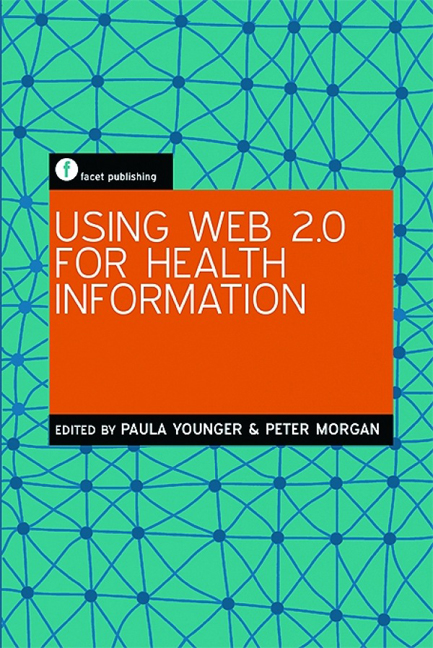Book contents
- Frontmatter
- Contents
- Preface
- Acknowledgements
- Contributors
- Glossary
- Introduction
- Part 1 The basics
- Part 2 Web 2.0 and the implications for health information
- Part 3 Web applications in health information provision: some practical examples
- 9 Web 2.0 in health libraries
- 10 RSS (Really Simple Syndication): helping faculty and residents stay up to date
- 11 Using mashups in health information provision
- 12 Twitter in a hospital library
- 13 Using Web 2.0 to facilitate staff development
- Part 4 The future
- Index
11 - Using mashups in health information provision
from Part 3 - Web applications in health information provision: some practical examples
Published online by Cambridge University Press: 08 June 2018
- Frontmatter
- Contents
- Preface
- Acknowledgements
- Contributors
- Glossary
- Introduction
- Part 1 The basics
- Part 2 Web 2.0 and the implications for health information
- Part 3 Web applications in health information provision: some practical examples
- 9 Web 2.0 in health libraries
- 10 RSS (Really Simple Syndication): helping faculty and residents stay up to date
- 11 Using mashups in health information provision
- 12 Twitter in a hospital library
- 13 Using Web 2.0 to facilitate staff development
- Part 4 The future
- Index
Summary
Introduction
Scholarly publications are the end product of research work. In most cases the budgets of research groups rely on the productivity of group members: how many articles have been published and what are the Impact Factors of the journals? Thus, scholars strive for maximum visibility and impression in their publishing efforts.
Terkko – Meilahti Campus Library (formerly: Terkko – National Library of Health Sciences, Finland), now part of the Helsinki University Library, has done pioneering work to highlight scholarly publications in medicine and health sciences at faculty, university and national level in Finland through innovative library services.
The Library is using the latest technologies to disseminate information about research done in Finland. This case study presents some of the key services that the Library is offering so as to increase the global visibility and substance of Finnish medical research, and the Web 2.0 tools that are offered to library customers.
Past
Virtual Journal of Helsinki Medical Research (VJHMR) was a monthly multijournal compilation of the latest research at the University of Helsinki. It was published from 2000 until 2005. At that time, the publication provided a good overview of the scholarly publishing of the faculty. It had a major influence on the development of comparable services, for example Lund University, Sweden, published Lund Virtual Medical Journal from 2002 until 2007 (now Lund Medical Faculty Monthly).
Technology
A Web 2.0. tool, RSS technology, prepared the way for more rapid and automatic alerting of new articles. An RSS web feed is a data format used with frequently updated content, such as the bibliographical data on scientific articles published in scholarly journals. FeedNavigator, a free web-feed aggregator made in Terkko, started as a medical and health sciences entity, but today it is a genuine multi-disciplinary alerting service. FeedNavigator downloads some 6000 feeds from journals, news services and blogs and also offers sophisticated tools that enable end-users to customize the interface. In addition, FeedNavigator downloads 600+ feeds of the latest articles published by Finnish scholars from the PubMed database. These feeds are the backbone of the Scholar Chart mashup.
- Type
- Chapter
- Information
- Using Web 2.0 for Health Information , pp. 115 - 120Publisher: FacetPrint publication year: 2011



